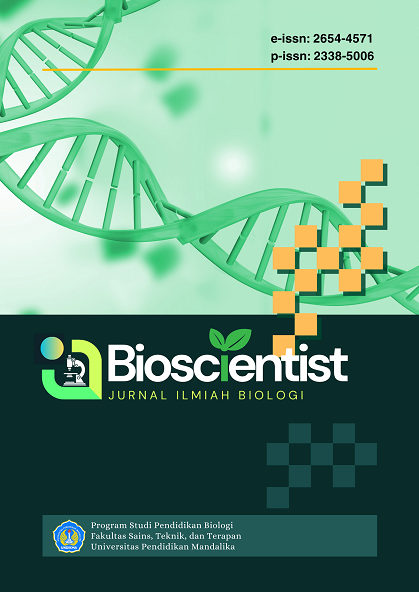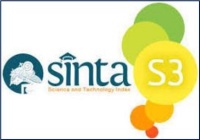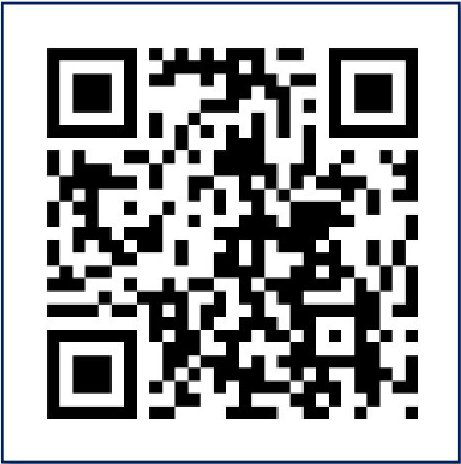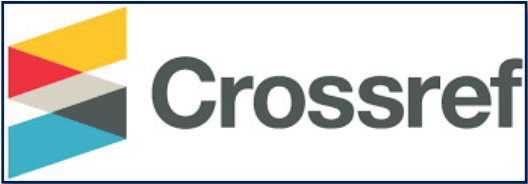Penerapan Model PBL Terintegrasi Flipped Classroom Terhadap Kemampuan Pemecahan Masalah Pada Materi Sistem Pertahanan Tubuh
DOI:
https://doi.org/10.33394/bioscientist.v13i3.16833Keywords:
PBL, flipped classroom, kemampuan pemecahan masalahAbstract
This study aims to investigate the effectiveness of the integrated Problem-Based Learning (PBL) model with the Flipped Classroom approach on students’ problem-solving skills in biology learning for Grade XI Phase F at SMAN 1 Kota Jambi. The main issue addressed in this research is the suboptimal implementation of the PBL model in the classroom due to limited instructional time. This study employed a quasi-experimental design using the nonequivalent pretest-posttest control group design. The research was conducted at SMAN 1 Kota Jambi during the even semester of the 2024/2025 academic year. The population consisted of Grade XI Phase F students, with Class XI F2 assigned as the experimental group and Class XI F7 as the control group, selected through purposive sampling and random sampling techniques. Data were collected using observation sheets and essay test instruments. The research data were analyzed using a One-Way ANCOVA test. The results indicated a significant difference between the experimental and control groups based on the One-Way ANCOVA test results [F(1,69) = 53.941, p < 0.001, ηp² = 0.439]. The obtained Partial Eta Squared value of 0.439 demonstrates a significant difference between the integrated Problem-Based Learning with Flipped Classroom model and the conventional Problem-Based Learning model. Based on these findings, it can be concluded that the integration of the Problem-Based Learning model with the Flipped Classroom approach is effective in enhancing the problem-solving skills of Grade XI Phase F students at SMAN 1 Kota Jambi.
References
Arends, R. I. (2015). Learning to Teach (Tenth Edition). In McGraw-Hill Education. McGraw-Hill Education.
Arnata, I. W., Mardana, I. B. P., & Suwindra, I. N. P. (2020). Pengaruh Model Pembelajaran Problem Based Flipped Classroom Terhadap Keterampilan Pemecahan Masalah Siswa Kelas Xi Ipa. Jurnal Pendidikan Fisika Undiksha, 10(1), 36.
Cahayu, S. A., Yelianti, U., Asrial, A., Wicaksana, E. J., & Nataliya, R. (2024). Efektivitas Problem Based Learning Berbasis Game Gurita Point dengan Lesson Study Terhadap Hasil Belajar Materi Klasifikasi Makhluk Hidup Pada Siswa SMP. Biodik, 10(1), 80–88.
Diyanti, S. K., Utama, C., & Winahyu, S. E. (2023). Efektivitas Model PBL Berbantuan Aplikasi Qreatif Terhadap Berpikir Kritis dan Motivasi Pembelajaran IPA Sekolah Dasar. Scholaria:Jurnal Pendidikan Dan Kebudayaan, 15(2), 171–180.
Ellis, P. D. (2010). The Essential Guide To Effect Sizes. In New York: Cambridge University Press.
Erita, S. (2023). Indonesian Journal of Science and Mathematics Education The Influence Of Problem-Based Learning-Flipped Classroom (PBL-FC) on Mathematical Argumentation Skills. 06(3), 395–404.
Habibullah, Wardono, & Waluya, B. (2024). Pengaruh Model Problem Based Learning terhadap Kemampuan Pemecahan Masalah Matematis pada Siswa Sekolah Menengah Pertama. PRISMA, Prosiding Seminar Nasional Matematika, 7, 1–6.
Hardiningsih, E. F., Masjudin, M., Abidin, Z., Salim, M., & Aziza, I. F. (2023). Penerapan Model Pembelajaran Project Based Learning Untuk Meningkatkan Kemampuan Pemecahan Masalah Statistika Matematika Siswa SMKN 2 Mataram. Reflection Journal, 3(1), 21–29.
Ivan, M., Ulfah, M., Awalludin, Novarita, Nilawijaya, R., & Fitriyyah, D. (2023). An Exploration into the Impact of Flipped Classroom Model on Cadets’ Problem-Solving Skills: A Mix Method Study. International Journal of Educational Methodology, 9(4), 745–759.
Jeet, V., & Sahotra, P. (2025). Active Learning Through the Flipped Classroom : Strategies to Improve Students ’ Learning and Performance. 23, 2395–2405.
Komala, R., Heryanti, E., & Rinawati, A. (2021). Effect of problem-based learning model on biodiversity problem-solving skills. Biosfer, 14(1), 120–131.
Kurniawati, I., Raharjo, T. J., & Khumaedi. (2019). Peningkatan Kemampuan Pemecahan Masalah untuk Mempersiapkan Generasi Unggul Menghadapi Tantangan abad 21. Prosiding Seminar Nasinal Pascasarjana, 21(2), 702.
Mardiyah, L., & Sunarsi, A. (2024). Problem-Based Learning and Flipped Classroom: Can it Improve Student Achievement? Edumatica : Jurnal Pendidikan Matematika, 14(01), 25–38.
Nissa, I. C. (2015). Teori dan Praktik Kemampuan Pemecahan Masalah. DUTA PUSTAKA ILMU.
Purba, D., Zulfadli, & Lubis, R. (2021). Pemikiran George Polya Tentang Pemecahan Masalah. Mathematic Education Journal, 4(1), 25–31.
Safitriyanti, D. E., Sumardi, H., Haji, S., & Zahara. (2023). Meningkatkan Kemampuan Pemecahan Masalah Melalui Penerapan Model Pembelajaran Problem Based Learning Di Smpn 1 Lebong. Penelitian Pembelajaran Matematika Sekolah (JP2MS), 7(1), 148–158.
Salsabila, A. A., Rustini, T., & Kusnadi, U. (2025). Perbedaan Antara Model Flipped Classroom Dengan Problem Based Learning Terhadap Kemampuan Pemecahan Masalah Pada Pembelajaran IPS Materi Keragaman Budaya. 20(1), 142–154.
Saraswati, C. P. D., Patmawatti, H., & Nattaliasari, I. (2021). Efektivitas Model Pembelajaran Flipped Classroom dalam Meningkatkan Kemampuan Matematis Peserta Didik pada Masa Pandemi COVID-19. Jurnal Pendidikan Indonesia, 2(10), 1639–1650.
Sari, R. K., Gorretty, M., Ariyanto, L., & Purwati, H. (2023). Upaya Meningkatkan Kemampuan Pemecahan Masalah Matematis Siswa Smk Dengan Pembelajaran Berbasis Masalah Berbantuan Geogebra. Eksponen, 13(1), 25–36.
Sriwahyuni, K., & Maryati, I. (2022). Kemampuan Pemecahan Masalah Matematis Siswa pada Materi Statistika. Plusminus: Jurnal Pendidikan Matematika, 2(2), 335–344.
Downloads
Published
How to Cite
Issue
Section
License
Copyright (c) 2025 anggi marviany

This work is licensed under a Creative Commons Attribution-ShareAlike 4.0 International License.













